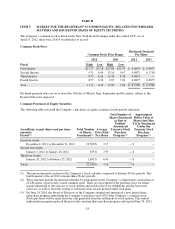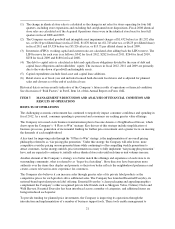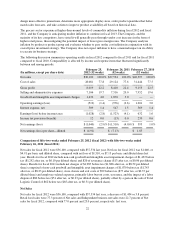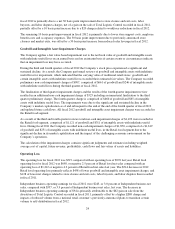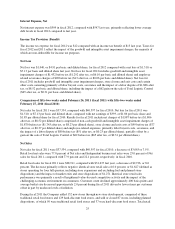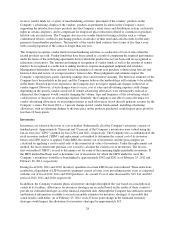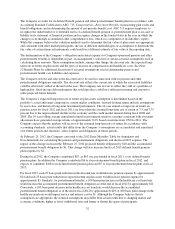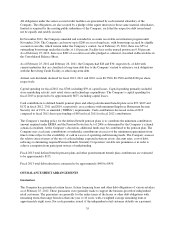Albertsons 2012 Annual Report Download - page 31
Download and view the complete annual report
Please find page 31 of the 2012 Albertsons annual report below. You can navigate through the pages in the report by either clicking on the pages listed below, or by using the keyword search tool below to find specific information within the annual report.Operating Earnings (Loss)
Operating loss for fiscal 2011 was $976 compared with operating earnings of $1,201 in fiscal 2010. Retail food
operating loss for fiscal 2011 was $1,212, or negative 4.2 percent of Retail food net sales compared with
operating earnings of $989 or 3.1 percent of Retail food net sales in fiscal 2010. The decrease in earnings of
$2,201 reflects goodwill and intangible asset impairment charges of $1,870, or 6.5 percent of Retail food sales,
reduced gross profit dollars primarily due to lower sales in fiscal 2011, store closure and exit costs of $99, or 0.3
percent of Retail food sales, and certain other costs primarily related to labor buy out costs, severance and the
impact of a labor dispute of $80, or 0.3 percent of Retail food sales. The remaining decrease of $152, or 20 basis
points, is primarily attributable to increased promotional spending and reduced sales leverage.
Independent business operating earnings for fiscal 2011 were $337, or 3.9 percent of Independent business net
sales, compared with $299, or 3.3 percent of Independent business net sales, in fiscal 2010. The increase
primarily reflects the gain on the sale of Total Logistic Control of $62, or 0.7 percent of Independent business net
sales.
Interest Expense, Net
Net interest expense was $547 in fiscal 2011, compared with $569 in fiscal 2010, primarily reflecting lower debt
levels in fiscal 2011.
Income Tax Provision (Benefit)
The income tax benefit was $13 for fiscal 2011 compared with a tax expense of $239, or 37.8 percent of earnings
before income taxes, in fiscal 2010. Taxes for fiscal 2011 reflect the impact of the goodwill and intangible asset
impairment charges, the majority of which are non-deductible for income tax purposes.
Net Earnings (Loss)
Net loss was $1,510, or $7.13 per basic and diluted share, for fiscal 2011 compared with net earnings of $393, or
$1.86 per basic share and $1.85 per diluted share in fiscal 2010. Net loss for fiscal 2011 includes goodwill and
intangible asset impairment charges, store closure and exit costs and certain other costs consisting primarily of
labor buyout costs, severance and the impact of a labor dispute of $1,806 after tax, or $8.52 per basic and diluted
share, partially offset by a gain on the sale of Total Logistic Control of $65 after tax, or $0.31 per basic and
diluted share. Net earnings for fiscal 2010 includes net charges of $39 after tax, or $0.18 per basic and diluted
share, related to planned retail market exits, closure of non-strategic stores and fees received from the early
termination of a supply agreement.
CRITICAL ACCOUNTING POLICIES
The preparation of consolidated financial statements in conformity with accounting standards requires
management to make estimates and assumptions that affect the reported amounts of assets and liabilities and
disclosure of contingent assets and liabilities as of the date of the financial statements and the reported amounts
of revenues and expenses during the reporting period. Actual results could differ from those estimates.
Significant accounting policies are discussed in Note 1 – Summary of Significant Accounting Policies in the
Notes to Consolidated Financial Statements included in Part II, Item 8 of this Annual Report on Form 10-K.
Management believes the following critical accounting policies reflect its more subjective or complex judgments
and estimates used in the preparation of the Company’s consolidated financial statements.
Vendor Funds
The Company receives funds from many of the vendors whose products the Company buys for resale in its
stores. These vendor funds are provided to increase the sell-through of the related products. The Company
27



